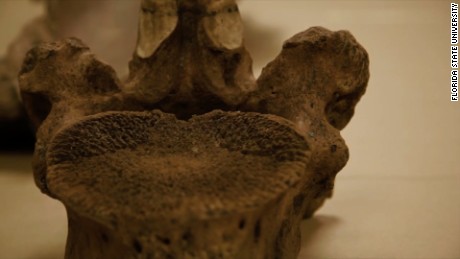The Finding of Mastodon Bones Leaves Questions

May 24, 2016
Some new fossils and artifacts have been discovered recently in Florida that may change the history of the southeastern United States.
Thanks to a study being performed by Florida State University, Mastodon bones and stone tools have been found at the bottom of a Florida river indicating that humans had been living in the area around 14,500 years ago. Many scientists believed that humans had begun inhabiting the area 1,500 years later than that. This leaves more questions open to how and when they got there.
Previously, the Clovis people (named after where their artifacts were found in Clovis, New Mexico) were believed to have been the first settlers of North America, around 13,500 years ago. Also known as Paleo-Indians, it’s been suspected that they were the people to cross the Bering Isthmus that connected Siberia to Alaska. The original Clovis era was said to range from 11,400 to 10,900 B.C., which was quite a bit of time before the Mastodons went extinct. Now that these new fossils and tools have been found, the time period in which these mammals disappeared could be completely altered.
There is an age-old speculation that there were other humans living in the area before the Clovis people arrived. A fisherman once found a 22,000 year old Mastodon head with a flaked blade that indicated that the Clovis people and all Native Americans had older ancestors than recently thought. This is where Paleontology, Anthropology and Archaeology come into play.
Senior Rob Sickler, who is avidly interested these subjects, included his thoughts on the new discoveries.
“One explanation would be that the people migrated to the Americas following these Mastodon herds for food; they may have hunted and harvested them with the tools found. This could open up new theories to human migration- as there are no previous records of hominids hunting Mastodons before the Clovis people in what is now New Mexico.”
Around 14,500 years ago, the planet was still coming out of an ice age. Rob also added that, “some of these fossils (mainly plant fossils) could show how much the climate can change during just a few thousand years”. Around 1,500 years later, the newest ice age came to an end, so any type of plant fossilized during the era could, in fact, reveal what may have happened to the weather in the area, and could even possibly explain the disappearance of this mystery population. It’s possible that plant fossils could be found at the same excavation site in the near future.
Whether or not old bones and tools interest you, it’s always important to know where you came from- and how we all got to where we are. So whether we came from Siberia or somewhere else unknown at the moment, new discoveries like these help the holes of our past be filled in.